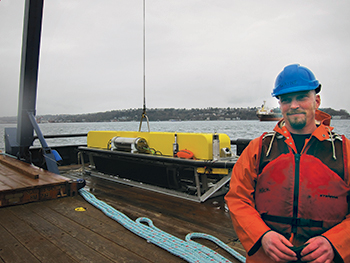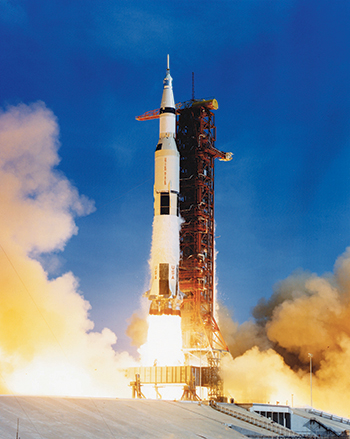Jay Larsen was towing a chirping sonar device three miles beneath the surface of the Atlantic Ocean, trolling the Bermuda Triangle for lost artifacts, when he discovered a trove of buried treasure that had spent more than 40 years lost at sea.
Larsen, a Flathead Valley native whose deep ocean surveying company, SL Hydrospheric LLC, is based out of Whitefish, was tapped two years ago to join the Apollo F-1 Engine Search and Recovery Team, led by Amazon founder and CEO Jeff Bezos.
His assignment was to locate one of the most powerful machines ever built – the F-1 engine of Apollo 11’s Saturn V rocket, which put three American astronauts on the moon.
After three weeks on board a retired Navy vessel, scanning the ocean floor with his specialized, 6,000-pound sonar vehicle, which hangs from the ship submerged in a watery abyss a full mile deeper than the Titanic wreckage, Larsen’s equipment began pinging off a graveyard of historic artifacts.
The Synthetic Aperture Sonar returned high-resolution images of the sea floor bristling with debris fields from a host of Apollo missions – thrust chambers, gas generators, injectors, heat exchangers, turbines, fuel manifolds, and dozens of other components from the colossal rocket engines. Still a modern wonder, the F-1 engine has 1.5 million pounds of thrust and 32 million horsepower, and is 18.5 feet tall and 12.2 feet wide.
 |
|
Jay Larsen of Whitefish-based SL Hydrospheric, LLC, pictured beside the company’s underwater sonar device. – courtesy of Jay Larsen |
On July 16, 1969, five of the F-1 engines were used to power the Saturn V rocket’s initial stage, lifting the booster off the launch pad at Cape Canaveral. After firing in concert for nearly three minutes, the F-1 engines were jettisoned, and fell from a height of about 40 miles before crashing into the ocean at terminal velocity. The force of the impact tore and mangled the engine parts, which sank to the seafloor in twisted disarray.
Several days later, Neil Armstrong alighted on the moon.
In a letter announcing the discovery and recovery of the engine parts, Amazon’s Bezos summed up his ambitions behind the expedition, calling it an homage to the spirit of human exploration and innovation.
“Millions of people were inspired by the Apollo Program. I was five years old when I watched Apollo 11 unfold on television, and without any doubt it was a big contributor to my passions for science, engineering, and exploration,” Bezos wrote. “A year or so ago, I started to wonder, with the right team of undersea pros, could we find and potentially recover the F-1 engines that started mankind’s mission to the moon?”
For Larsen, the most rewarding part of the expedition was that it was so richly steeped in history.
“That is what I love about going out on these searches. You go out there for a month and you are basically going through a big history lesson. You get this huge injection of history, and it’s very pointed,” he said. “To be part of the expedition was pretty amazing.”
Last week, Larsen and the search and recovery team were honored by The Explorers Club – an ultra-famous New York club of legendary explorers, whose vaunted members include the first Mount Everest climber Edmund Hillary, as well as the first moon walker, Armstrong.
Larsen and his wife, Katrina, attended an awards dinner at the storied Waldorf Astoria hotel in Manhattan, where they noshed exotic hors d’oeuvres, including Madagascar hissing cockroaches, and rubbed elbows with the likes of Bezos, Buzz Aldrin and Elon Musk.
“The awards dinner was really, really inspiring. To be in an audience and hear speeches by Jeff Bezos, Buzz Aldrin, Brian Green, Stephen Hawking, Elon Musk and other great innovators and explorers was incredibly, again, inspiring,” Larsen said. “Katrina and I had one of the nights of our lives interacting with so many interesting people and we were especially proud to be a part of the team that was actually receiving one of the awards, with our homegrown company out of Whitefish.”
Led by explorer and attorney David Concannon, one of only a handful of people to have joined The Explorers Club before the age of 30, the Apollo F-1 Engine Search and Recovery Team received the Citation of Merit for an Outstanding Feat of Exploration. The award was presented to Bezos and the team by the club’s president, Alan Nichols, and Apollo 11 astronaut Aldrin, who in 1969 joined Armstrong to become the first men to walk on the moon.
In 2012, Concannon reached out to Larsen about using his system in the search for the F-1 engines because it offers a specialized technology, producing high-resolution images and providing high-area coverage at a depth rating of 6,000 meters, meaning it must be able to sustain 8,800 pounds per square of inch of pressure.
“That’s one of the big challenges for us,” Larsen said. “This has been a technologically interesting project that has tweaked all of my nerdy engineering buttons at some point or another, sometimes to extremes.”
 |
|
The Saturn V rocket launches during the Apollo 11 mission to the moon. |
Reached by email, Concannon said the mission would not have been successful without the Whitefish company’s sonar technology and the deep-sea expertise of its crew members.
“Jay Larsen and SL Hydropsheric played an integral role in the F-1 Project. Without them, we simply would not have been successful in locating the Apollo rocket engines,” Concannon said. “Jay’s enthusiasm and hard work were infectious, and it was a pleasure to work with him. I look forward to our next adventure together.”
While the mission delivered the most accolades on SL Hydrospheric to date, it wasn’t the first time he’s helped exhume history from the ocean’s yawning depths.
He worked for a deep ocean search and survey outfit in Seattle and helped discover the USS Grunion off Kiska Island in the Aleutians, as well as the wreckage of HMS Centaur off the east coast of Australia. The Centaur was an Australian hospital ship torpedoed and sunk by a Japanese submarine in 1943.
The incident was considered a war crime.
Larsen and his crew discovered the ship in 2009. He said the aftermath was interesting as Australia requested a formal apology, which the Japanese denied.
The company also conducted searches for Spanish galleons off the coast of Panama, including a search in the mid-Atlantic for a Spanish galleon, the wreckage of which was entrenched in 5,000 meters of water.
“It was during the galleon searches that the need for super high resolution sonar became apparent, since most of the wood is usually gone and we’re looking for ballast piles (river rock) strewn with artifacts, like 12-foot cannons,” he said. “The sonar we were using just couldn’t give the resolution and cover a lot of ground. That is the tradeoff – high resolution requires high frequency but that attenuates in water so range, and therefore area coverage, becomes extremely limited.”
Missing Montana, Larsen returned to the Flathead Valley to raise a family and, eventually, start his own business. He and his business partner, Colin Stewart, acquired warehouse space in Seattle, received a Small Business Administration loan and developed their sonar vehicle, power and telemetry system.
The main technology that sets them apart from other survey outfits, and puts the company on the cutting edge of deep ocean exploration, is the digital signal processing, which processes the sonar returns into high-resolution images even at long ranges, and provides a high depth rating.
“I’ve been out with people who work in the Navy and they’ve said, ‘Not even the U.S. Navy has a system like this,’” Larsen said.
Using an old crabbing ship or, in the case of the F-1 mission, a former anti-submarine warfare vessel, Larsen and his crew tow the sonar on cables more than four miles long.
“Sometimes as I’m driving around the valley I look at Columbia Mountain and think in terms of that – towing a sonar in 4,500 meters of water that is as deep as three-and-a-half times the vertical rise of Columbia Mountain from Bad Rock Canyon,” Larsen said.
“For this project, we were trying to get as high of a resolution as possible so we were towing as close as 5 meters above the sea floor, thanks to good ship handling by the captain and mate,” he added.
Following Larsen’s discovery, a fleet of Remotely Operated Vehicles worked to recover the parts at a depth of more than 14,000 feet, tethered to a different ship with fiber optics for data and electric cables transmitting power at more than 4,000 volts.
Although the F-1 engines officially remain the property of NASA, Bezos is working with the agency to donate one of the engines to the Smithsonian Museum and the other to the Space and Flight Museum in Seattle. He hopes displaying the techno-wonders will inspire the spirit of exploration in generations to come.
“NASA is one of the few institutions I know that can inspire five-year-olds. It sure inspired me, and with this endeavor, maybe we can inspire a few more youth to invent and explore,” Bezos wrote.
Larsen and his company have other ventures – and adventures – on the horizon, including a possible contract with a treasure hunting company in Florida whose aim is to recover sunken gold and silver from historic shipwrecks. The company recovered 61 tons of silver from the wreck of the SS Garisoppa, a merchant ship torpedoed by a German U-boat in 1941, off Ireland’s coast.
Hydrospheric’s technology would also be well-suited for a Malaysian Air Flight 370 search, he said, and one of the company’s first bids was on the search for Air France 447, but the company wasn’t quite ready with its technology at the time.
“If there ever comes a well-defined search area we would be an ideal candidate to go look for this wreck and I’ve alredy put out the word to the right people that we are available,” Larsen said.